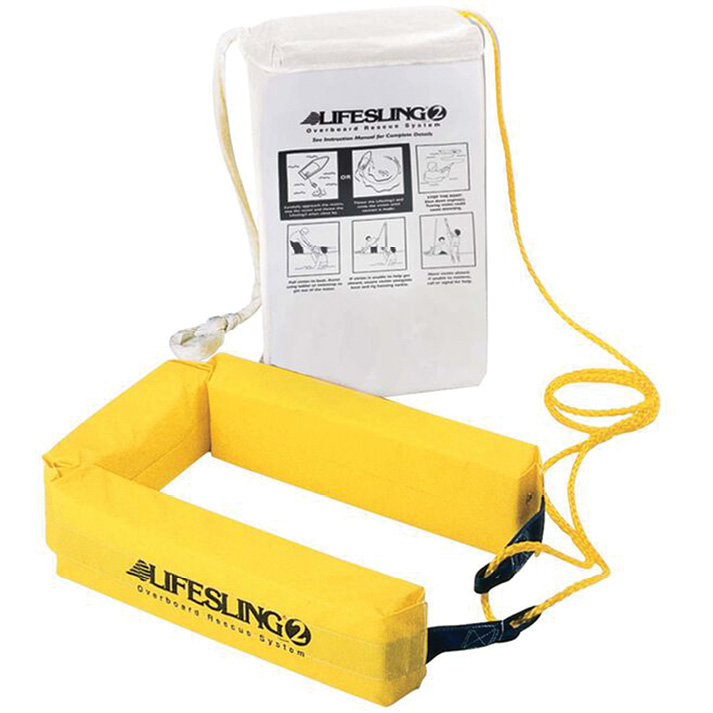Letters – by Our Readers

Hi Captain Pat,
I hope you are doing well and enjoying the boating season. While at the fuel dock at Emeryville Marina my mom fell into the water while stepping off the boat onto the dock to catch lines. She had no life jacket on and has limited mobility due to some health challenges she deals with. Given this situation it took a lot of time for us to help get her out of the water. She was very cold due to the temperatures of the Bay. After a while with the help of some fishermen on the dock, we finally were able to fashion a sort of sling using an orange life jacket, towels and rope and get my mom up the swim ladder before she got too cold.
The incident was frightening for all of us and it made us think that maybe it would be a good idea to have tools or some sort of rescue plan should a similar incident happen again when there may not be others to help. What swim methods would you recommend for rescuing a boater with limited mobility from the water should they fall overboard? Also, what tools would you recommend having on board your vessel for such a rescue.
Sincerely, Daniel
Daniel,
That is a very scary situation. Glad to hear that it did not result in a serious accident with medical implications.
One of the discussion topics in our training curriculum is how to rescue a person in the water, PIW, that cannot assist in their own recovery due to loss of muscle control, unconsciousness or lack of a nearby boarding ladder. Yes, SF Bay waters are cold, 56 degrees or so, but a person that has fallen in will have many minutes up to several hours depending on factors such as body size, body fat, and any protective clothing before hypothermia has a chance to inhibit muscle control. ABYC requires that recreational vessels have a boarding ladder that can be deployed by a person from the water. These ladders are often the first choice to get a person back on board even if they need some assistance from a person on the swim platform or dock.
A very popular device that we see on almost every sailing vessel is the Lifesling. It is a combination of a horseshoe buoy and a helicopter rescue sling. The caveat is that it is designed to be used on motor yachts with a lifting point at least ten feet above the water or on larger sailboats.

For a person that is unconscious or for whatever reason cannot assist with their own rescue and needs to rely on others to get them back on board, the Lifesling is a popular choice for many boaters, especially sailors where reboarding a sailboat can be quite difficult. There are many different versions with some of them USCG and SOLAS approved as a Type IV device which can replace the ring or cushion as the required throwable flotation device.
First, of course, is prevention. A person with limited mobility for whatever reason should not be responsible for stepping off a moving vessel and onto a dock to secure lines, especially if not wearing an appropriate personal flotation device. I know firsthand that accidents do occur around a dock due to the unpredictable movement of the vessel, as well as the many trip hazards on both the vessel and the dock.
If the person is not wearing a PFD, the first action should be to throw them a ring, buoy or Lifesling and then call for assistance. After they have been reboarded, it is important to check for any injuries and the possibility of hypothermia. I believe that everyone should take a basic first aid class and be current. Every vessel should also have a first aid kit, and if you regularly have passengers or crew with medical issues, it is a good idea to keep an Automatic External Defibrillator, AED, on board. The basic first aid courses almost always include training on how to use these devices. Remember, sudden cold-water immersion can increase the risk of a heart attack by triggering a rapid increase in heart rate, blood pressure and breathing rate. This normal physiological response can strain the heart, especially for people with underlying heart conditions.
Having a rescue plan is crucial and is developed based on the vessel and the likely crew and passengers. On commercial boats every vessel has a written rescue plan and MOB drills are conducted regularly as mandated by the USCG. Develop your plan and then go someplace warm, with calm water and practice. Summertime in the Delta is perfect and you won’t have any trouble finding a volunteer to be the PIW.
Thank you for writing as this is a very important subject and you are not the first vessel operator to have someone fall from the vessel and need assistance getting back on.
Pat
Send your letters to:
E-mail preferred.
Please refer to Writer’s Page for each writer’s personal e-mail address.



